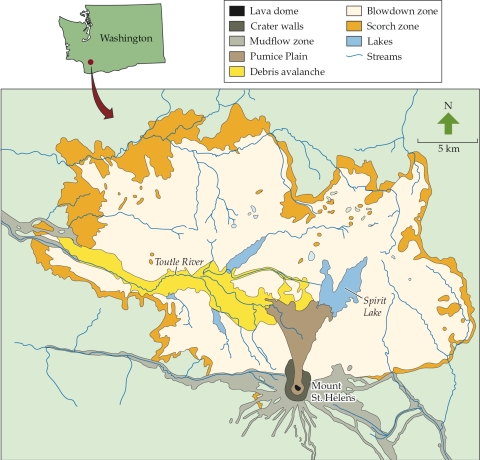Course
Ecology
Study Pack
Set 17 Change In Communities
Question 1
(Multiple Choice)
Free
Refer to the figure.
 On Mount St. Helens, the intensity of disturbance ranged from extremely high (lava dome, pumice plain) to moderate (mudflow zone, blowdown zone), to low (scorch zone).
On Mount St. Helens, the intensity of disturbance ranged from extremely high (lava dome, pumice plain) to moderate (mudflow zone, blowdown zone), to low (scorch zone).
-In which area is the abiotic stress of low nitrogen availability most likely to control succession?
 On Mount St. Helens, the intensity of disturbance ranged from extremely high (lava dome, pumice plain) to moderate (mudflow zone, blowdown zone), to low (scorch zone).
On Mount St. Helens, the intensity of disturbance ranged from extremely high (lava dome, pumice plain) to moderate (mudflow zone, blowdown zone), to low (scorch zone). -In which area is the abiotic stress of low nitrogen availability most likely to control succession?
A) Pumice Plain
B) Mudflow zone
C) Blowdown zone
D) Scorch zone
Answer
Question 2
(Multiple Choice)
Free
Refer to the figure.
 On Mount St. Helens, the intensity of disturbance ranged from extremely high (lava dome, pumice plain) to moderate (mudflow zone, blowdown zone), to low (scorch zone).
On Mount St. Helens, the intensity of disturbance ranged from extremely high (lava dome, pumice plain) to moderate (mudflow zone, blowdown zone), to low (scorch zone).
-In which area is the biotic stress of competition most likely to control succession?
 On Mount St. Helens, the intensity of disturbance ranged from extremely high (lava dome, pumice plain) to moderate (mudflow zone, blowdown zone), to low (scorch zone).
On Mount St. Helens, the intensity of disturbance ranged from extremely high (lava dome, pumice plain) to moderate (mudflow zone, blowdown zone), to low (scorch zone). -In which area is the biotic stress of competition most likely to control succession?
A) Pumice Plain
B) Mudflow zone
C) Blowdown zone
D) Scorch zone
Answer
Question 3
(Multiple Choice)
Free
Which statement about change in communities is true?
A) Only biotic factors can be agents of change.
B) Only abiotic factors can be agents of change.
C) Disturbances create opportunities for some species to grow or reproduce due to the injury or death of other individuals.
D) "Stress" and "disturbance" are interchangeable words that describe the same processes.
Answer